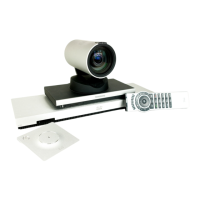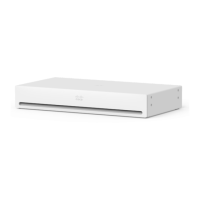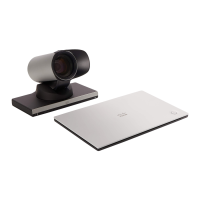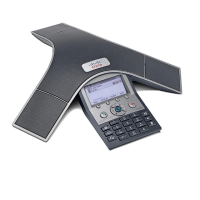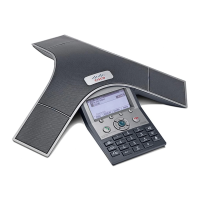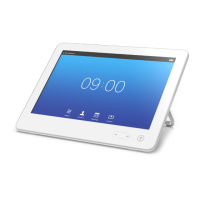31
Cisco TelePresence System Quick Set C20 / C20 Plus and Profiles using C20 Administrator guide
D14637.04 Profile C20 and Quick Set C20 Administrator Guide TC4.0, November 2010.
Copyright © 2010 Cisco Systems, Inc. All rights reserved.
www.cisco.com
Conference [1..1] VideoBandwidth Mode
Set the conference video bandwidth mode.
Requires user role: ADMIN
Value space: <Dynamic/Static>
Dynamic: The available transmit bandwidth for the video channels are distributed among the
currently active channels. If there is no presentation, the main video channels will use the bandwidth
of the presentation channel.
Static: The available transmit bandwidth is assigned to each video channel, even if it is not active.
Example: xConguration Conference 1 VideoBandwidth Mode: Dynamic
Conference [1..1] VideoBandwidth MainChannel Weight
The available transmit video bandwidth is distributed on the main channel and presentation channel
according to "MainChannel Weight" and "PresentationChannel Weight". If the main channel weight is 2
and the presentation channel weight is 1, then the main channel will use twice as much bandwidth as the
presentation channel.
Requires user role: ADMIN
Value space: <1..10>
Range: 1 to 10.
Example: xConguration Conference 1 VideoBandwidth MainChannel Weight: 5
Conference [1..1] VideoBandwidth PresentationChannel Weight
The available transmit video bandwidth is distributed on the main channel and presentation channel
according to "MainChannel Weight" and "PresentationChannel Weight". If the main channel weight is 2
and the presentation channel weight is 1, then the main channel will use twice as much bandwidth as the
presentation channel.
Requires user role: ADMIN
Value space: <1..10>
Range: 1 to 10.
Example: xConguration Conference 1 VideoBandwidth PresentationChannel Weight:
5
Conference [1..1] PacketLossResilience Mode
Set the packetloss resilience mode. This configuration will only take effect for calls initiated after the
configuration is set.
Requires user role: ADMIN
Value space: <On/Off>
On: Enable the packetloss resilience.
Off: Disable the packetloss resilience.
Example: xConguration Conference 1 PacketLossResilience Mode: On
H323 NAT Mode
The firewall traversal technology creates a secure path through the firewall barrier, and enables proper
exchange of audio/video data when connected to an external video conferencing system (when the IP
traffic goes through a NAT router). NOTE: NAT does not work in conjunction with gatekeepers.
Requires user role: ADMIN
Value space: < Auto/On/Off>
Auto: The system will determine if the "NAT Address" or the real IP-address should be used within
signalling. This is done to make it possible to place calls to endpoints on the LAN as well as endpoints
on the WAN.
On: The system will signal the configured "NAT Address" in place of its own IP-address within Q.931
and H.245. The NAT Server Address will be shown in the startup-menu as: "My IP Address: 10.0.2.1".
Off: The system will signal the real IP Address.
Example: xConguration H323 NAT Mode: Off
H323 NAT Address
Enter the external/global IP-address to the router with NAT support. Packets sent to the router will then
be routed to the system.
In the router, the following ports must be routed to the system's IP-address:
* Port 1720
* Port 5555 to 5574
* Port 2326 to 2485
Requires user role: ADMIN
Value space: <S: 0, 64>
Format: String with a maximum of 64 characters.
Example: xConguration H323 NAT Address: ""
H323 Profile [1..1] PortAllocation
The H.323 Port Allocation setting affects the H.245 port numbers used for H.323 call signalling.
Requires user role: ADMIN
Value space: <Dynamic/Static>
Dynamic: The system will allocate which ports to use when opening a TCP connection. The reason
for doing this is to avoid using the same ports for subsequent calls, as some firewalls consider this
as a sign of attack. When Dynamic is selected, the H.323 ports used are from 11000 to 20999. Once
20999 is reached they restart again at 11000. For RTP and RTCP media data, the system is using
UDP ports in the range 2326 to 2487. Each media channel is using two adjacent ports, ie 2330 and
2331 for RTP and RTCP respectively. The ports are automatically selected by the system within
the given range. Firewall administrators should not try to deduce which ports are used when, as the
allocation schema within the mentioned range may change without any further notice.
Static: When set to Static the ports are given within a static predefined range [5555 to 6555].
Example: xConguration H323 Prole 1 PortAllocation: Dynamic
The H323 Profile settingsThe Conference settings, continued...
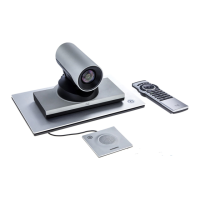
